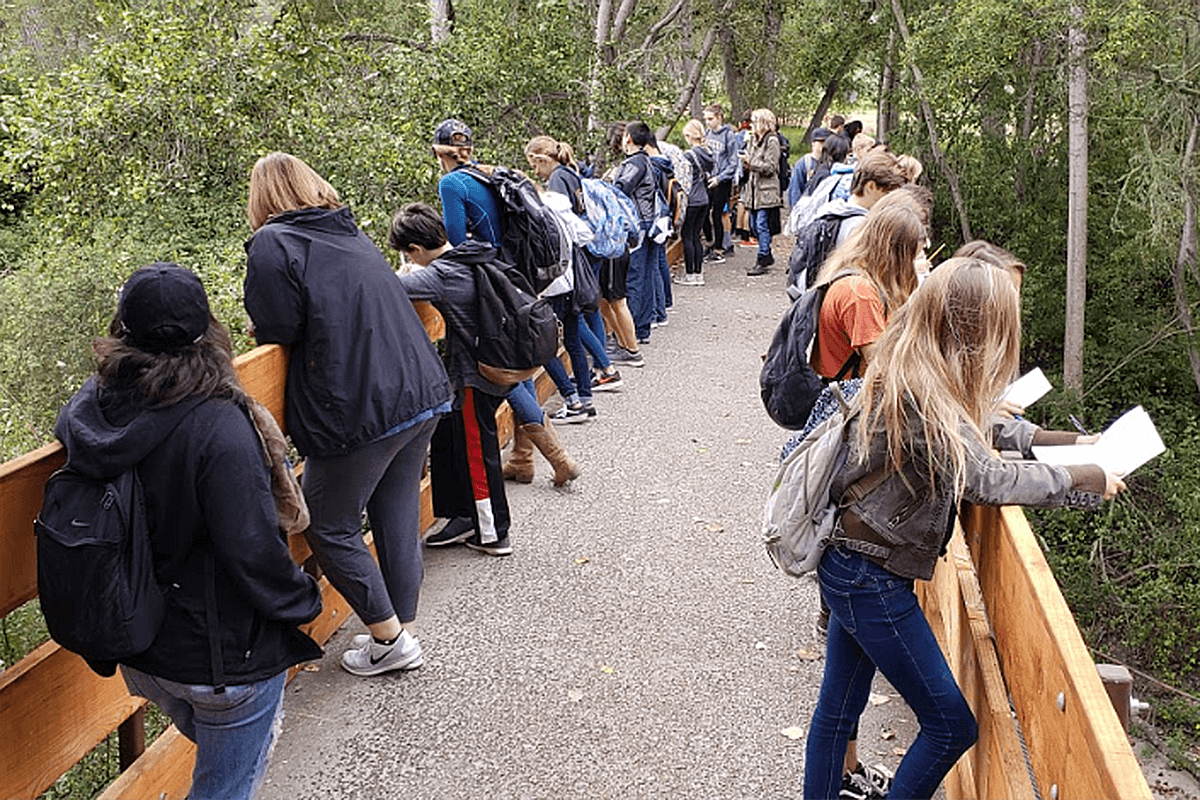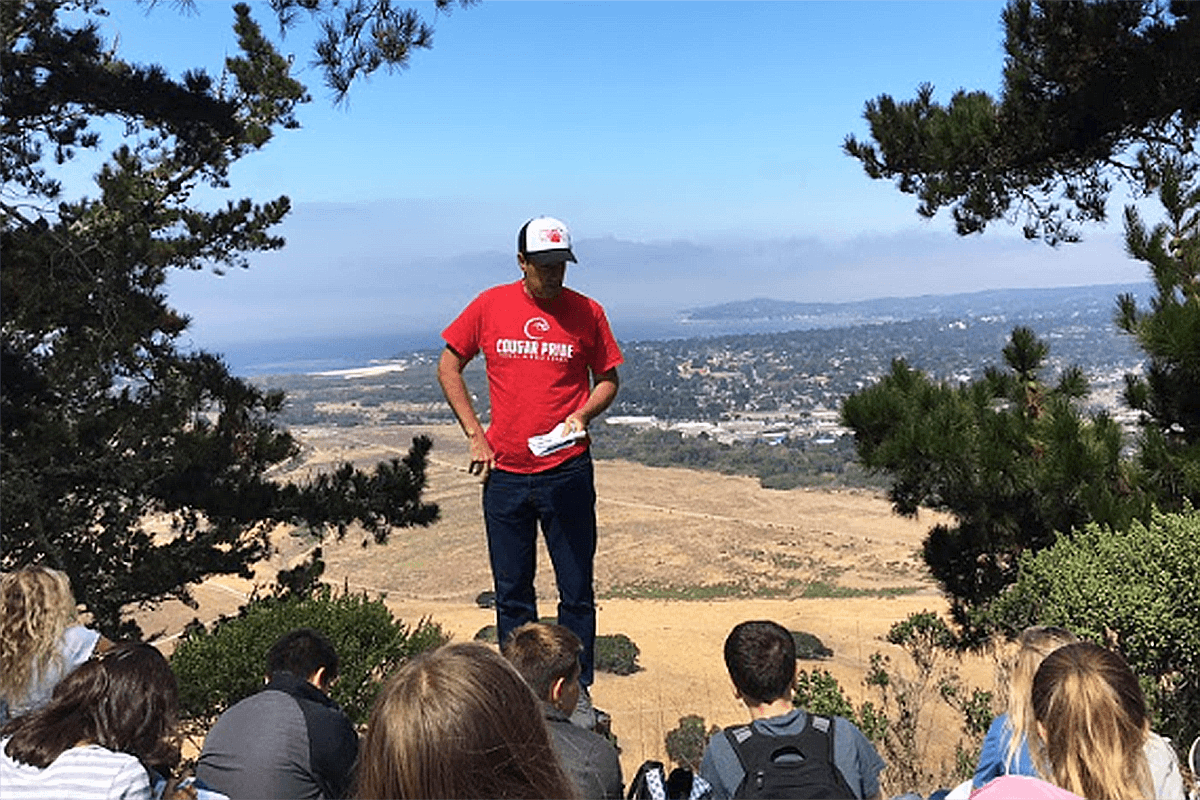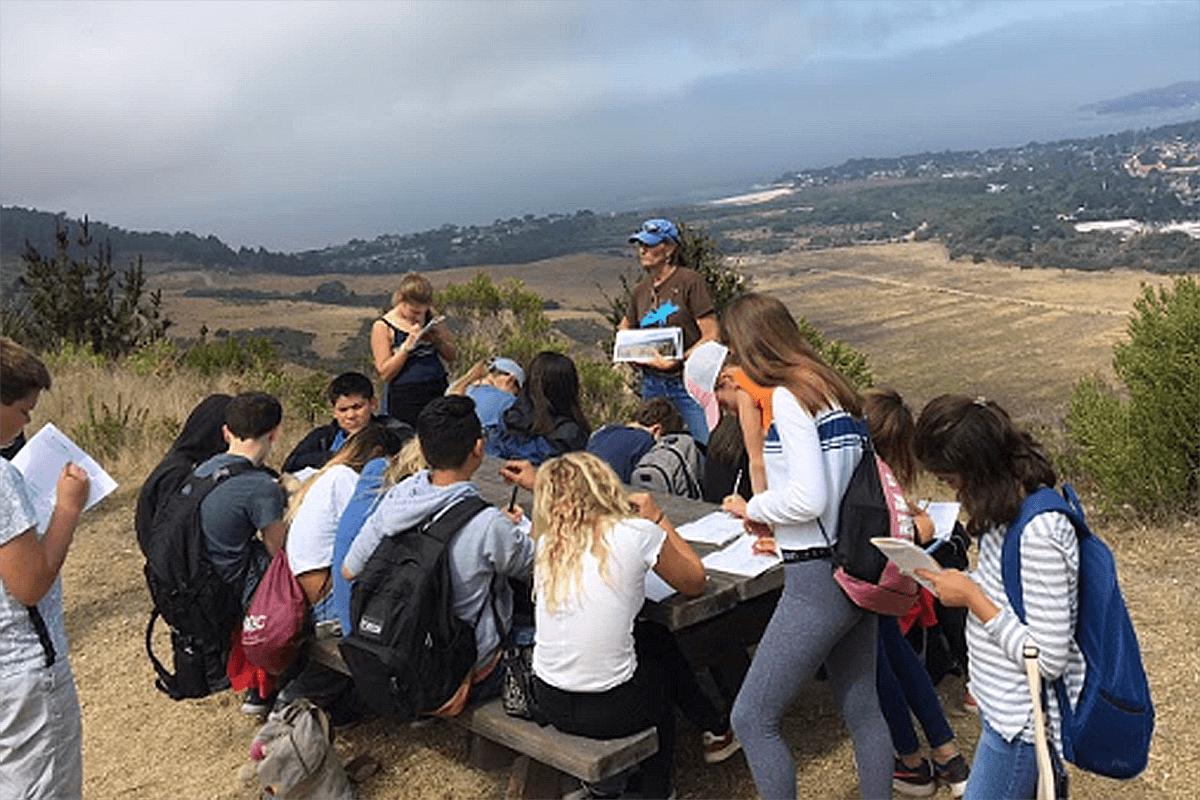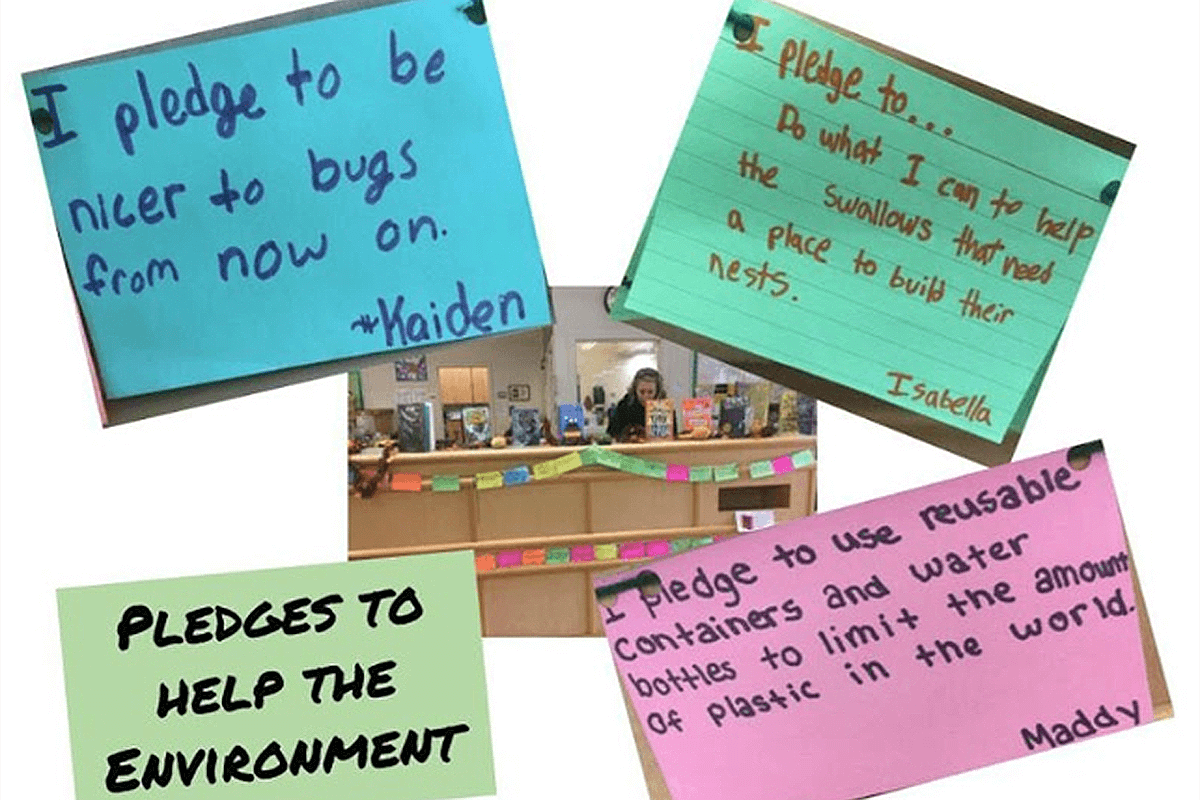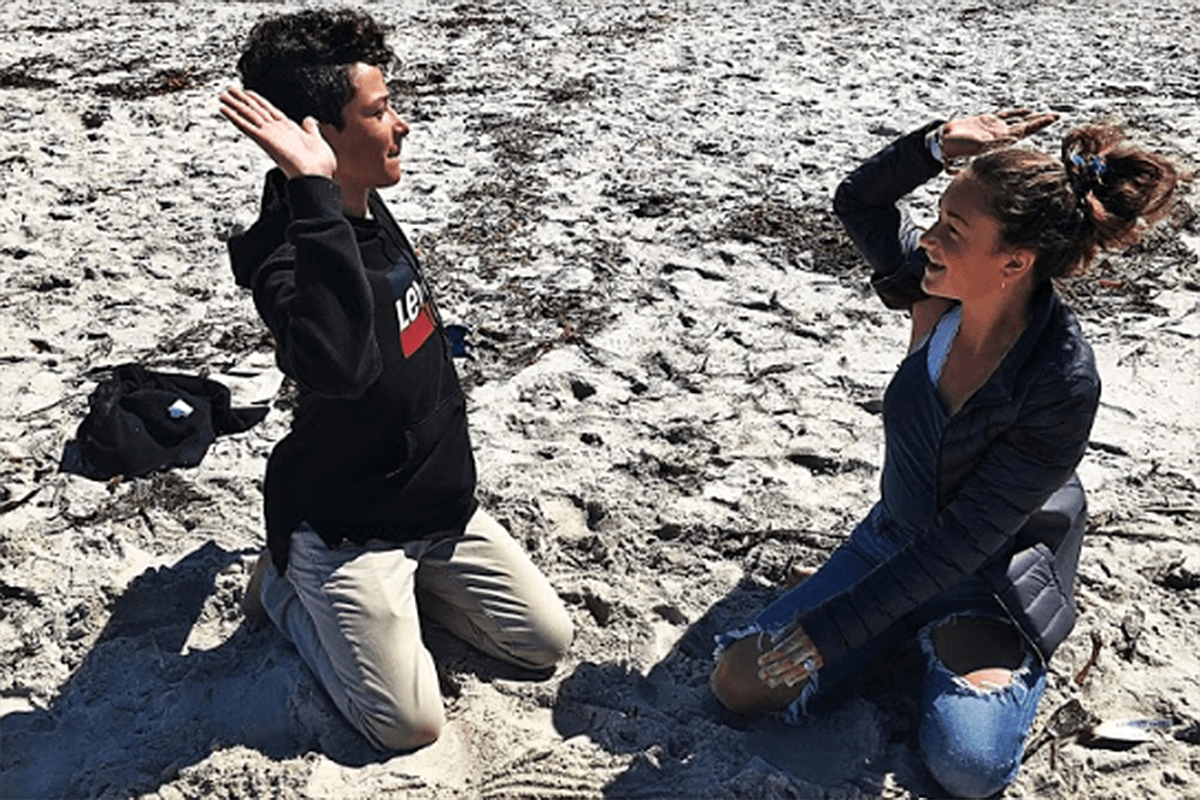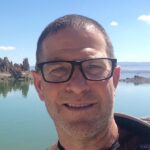MONTEREY BAY OUTDOOR EDUCATION PROGRAM
Every year all of Carmel Middle School’s seventh grade students participate in the Monterey Bay Outdoor Education (MBOE) program. The main goals of this place-based program are to connect students to their local environment and increase their understanding of the interconnection between humans and nature. Students spend three consecutive days outside at three local destinations: Carmel Beach, Elkhorn Slough National Estuarine Research Reserve, and Palo Corona Regional Park. The destinations were selected for their unique diversity, regional climate, richness of land–sea connection, and opportunities to connect with local community organizations.
To allow for quality time at each location, the seventh graders divide into three groups and each group rotates through the locations over the three days. The lessons and hands-on activities at each location intertwine nature and course content, including art, science, history–social science, physical education, and language arts. While all of the destinations receive positive feedback from the community, the trip to Palo Corona is described below as an example of how schools and communities can work together to support student environmental literacy. Palo Corona is a special trip for many students, as it is a newly opened park and many students have not yet had the opportunity to visit—even though they see it every day from their school.
PALO CORONA
The Palo Corona mountains lie just south of Carmel Middle School, and Palo Corona Regional Park is an open space community park in the school’s “backyard.” The park, managed by Monterey Peninsula Regional Park District, spans over 4,500 acres and stretches approximately 10 miles from north of the Carmel River south to Big Sur. It includes the headwaters of 13 watersheds, and provides a habitat for several rare, endangered, and unusual plants and animals. The park is considered a conservation success, a result of partnerships between individuals, community groups, and governmental agencies.
The student experience consists of two parts separated by a lunch session. The first part is an ecologically-themed hike up to the top of Palo Corona. At the top, the students enjoy lunch, then split into three smaller groups and rotate through three different learning activities: a poetry lesson, a historical mapping activity, and a discussion about conservation.
THE HIKE
The morning began with a hike that was approximately two miles long, with a climb of 650 feet. The trail zig-zags over the Carmel River and through several different habitats, including a riparian woodland, a coast live oak woodland, a coastal sagebrush community, and a Monterey pine forest. At each habitat along the way the students were given time to observe and reflect on their surroundings and record in their journals.
Their MBOE journals contain prompts encouraging students to notice and question the different features of the habitat like smells, size and shape of plants, birds, amount of sunlight, and temperature. These stops were strategically planned so that students observe, ask questions, and describe the living and nonliving components of each habitat. As they began to notice the patterns observed at each habitat questions arose: Why are there different habitats? Does sun exposure matter? What animals live here? Why is it colder in this location? Why are the trees different at different locations on the hill?
The trip was challenging for some students, and the stops not only gave students opportunities to observe nature—they also provided important time for water and rest. Driving accommodations were available so that all students, regardless of physical ability, had the opportunity to experience this amazing location. Upon reaching the summit, students were rewarded with a breathtaking view. From this viewpoint, appropriately named Inspiration Point, students looked out over the Pacific Ocean, the Carmel River, their local hangouts, and their school as they ate their lunch.
ENGLISH LANGUAGE ARTS: POETRY
Nature has inspired many writers. Language arts teacher Bryn Loosley chose the local Carmel poet Robinson Jeffers’ poem “Rock and Hawk” to inspire students to think and write about contrasts in nature. Students read Jeffers poem and used it as a model to compose their own poems. Carmel Middle School student Riley M. reflected on what she had learned and seen to write this powerful, thought-provoking poem:
Have we forgotten our place?
Have we lost our memories of calm?
When the sound of the road
Was the rush of a river
All lost to the current of
Time?
When we had not plastic
But earth
Not metal
But rock
Not the grinding of machines, but
The gentle songs of birds.
If we could taste a droplet
Of the water that was
Is it possible that we
As humans
As animals of Earth
Could go back?
HISTORY–SOCIAL SCIENCE: LOCAL HISTORY
The outdoor history lesson incorporated a mapping activity that allowed students to think about how the environment has changed over time, and how it has influenced and been influenced by human development. Social studies teacher Anna Williams designed an engaging lesson that involved the mapping of historical landmarks, comparing them to the current view, and describing how they have (or have not) changed over time. As students labeled and colored a map of the valley, Anna engaged students with questions to encourage critical-thinking skills: How has the environment of the Carmel Valley influenced human history in this area? How have humans changed the environment of the Carmel Valley? What is the future of the Carmel Valley? Anna’s family history goes back many generations in Carmel Valley, and her sharing of personal stories and photographs gave students additional insight to consider how humans have interacted with the local environment over time.
CONSERVATION
Conversations about conservation were integrated into all the activities, especially with the activity led by Jackie Nelson, environmental education supervisor at Monterey Regional Park District. Sitting alongside a grassy field, Jackie led students in a discussion about the complex and real issues regarding conservation. In their discussion, the students considered how the land should be managed by the community today and for future generations. Questions such as: What are the benefits and ecosystem services of open spaces? Should dogs be allowed? Why are there cattle under the oak trees? Can mountain bikers and hikers share trails? Can people live here? What about the native plants and animals?
The students were given time to journal about what conservation means to them, how they can conserve resources, and how conservation efforts can impact communities. Students had different viewpoints how the land should be used, and began to see the complexity of conservation decisions and projects such as Palo Corona.
HOPE, INSPIRATION, and EMPOWERMENT
On the final morning, all of the students joined together to meet in the theater for a presentation featuring students who have taken action and are making a difference. During the presentation students watched a movie featuring two Carmel High School students that drew national attention to the environmental consequences of golf balls in the ocean. They also learned about how palm oil is harvested, and were inspired by hearing about two middle school students who influenced the national Girl Scouts’ decision to eliminate palm oil from Girl Scout cookies. Finally, they were inspired by one of their own classmates as she described the dangers of plastic pollution and how she took action and encouraged Carmel’s city council to institute a ban on plastic straws in local restaurants.
The stories provided hope and inspiration for the students. All 200+ students were then given time to reflect on the lessons of the week, and to create an expression of how they will make a difference, big or small, in their world. The pledges were written on colorful note cards and displayed in the school library.
THE POWER OF PARTNERSHIP
The MBOE program is an example of how a school and a community can come together to promote environmental literacy and California’s Environmental Principles and Concepts. It is a success year after year because of the collaborative efforts between teachers, parents, community organizations, and administrators.
In 2018, Carmel Middle School partnered with California State Parks, Elkhorn Slough National Estuarine Reserve, MEarth, Monterey Peninsula Regional Parks, Monterey Bay National Marine Sanctuary, and Pacific Grove Natural History Museum for outdoor learning experiences.
It is a special part of the seventh grade learning experience because it provides every student an opportunity to learn about their local environment through the lens of authentic, relevant experiences and incorporates multiple subject areas including science, math, social studies, and language arts. Because this event occurs simultaneously at three different locations, and includes the entire seventh grade class, this program would not be possible without the support of, and collaboration with, the involved partners.
ENVIRONMENTAL STEWARDSHIP
MBOE is just one example of how the local community and the environment are intertwined throughout the courses and curriculum at Carmel Unified School District (CUSD). All the school sites have gardens, and a recent survey given to district teachers revealed that nearly 86% of CUSD teachers reported making classroom connections to nature or the environment; 60% of those teachers do so more than once a month. This transcends classrooms and becomes part of district culture: CUSD’s governance handbook states “we have a responsibility for the environment.” Additionally, the board of trustees included the phrase “a steward for the environment” in the superintendent’s job description. This specific phrase caught the attention of our new superintendent Barb Dill-Varga.
As a result of this district-level dedication to the environment, CUSD has received many awards, including being the first Ocean Guardian District in the nation and Carmel Middle School is a Green Ribbon Award winner.
ENVIRONMENTAL RESPONSIBILITY TEAM
At the heart of the district’s commitment to the environment is CUSD’s Environmental Responsibility Team (ERT). The team was established in 2012 to support the district’s long-range goals and objectives, specifically Objective 3.3 to “increase environmental literacy and stewardship across the district with a focus on understanding our impact on the environment and the importance of conserving resources.”
This team includes teachers, administrators, high school students, parents, the director of maintenance and operations, the chief academic officer, and the superintendent. Every school site within the district is represented in this group, and the team meets regularly to brainstorm ways to reduce CUSD’s environmental footprint, network, and share accomplishments in environmental literacy and community involvement.
In 2017, the goals of this committee were modified and aligned with the three pillars of The Green Ribbon Schools program:
- reduce environmental impact and costs (Pillar I);
- improve the health and wellness of schools, students, and staff (Pillar II); and
- provide effective environmental education, which teaches many disciplines, and is especially good at effectively incorporating STEM, civic skills, and green career pathways (Pillar III).
In an attempt to meet these goals, the ERT team formed three working groups: a communications group, a curriculum group, and an operations group. The communications group is currently creating a website to host blog entries and to share our successes with our community and other schools. The curriculum group is compiling lessons from teachers that promote environmental literacy and California’s Environmental Principles and Concepts in the district’s classrooms (enabling the group to generate a scope and sequence document that can be used as a baseline to set future goals). The operations group is working to reduce the district’s environmental footprint by focusing on energy use, waste reduction, recycling, composting, water use, school lunches, and restoration projects.
As educators, we encourage students to keep an open mindset in regards to learning. In a similar manner, the work of the ERT is never-ending and there is always room for growth. The team sets goals to promote environmental literacy in the classroom, and to promote environmental stewardship at our facilities.
In her poem above, Riley considers a time when rivers were clean and plastic pollution did not exist. Her poem serves as both inspiration and a wake-up call for all of us, including educators and school district leadership. How can we educate our students without thinking about their future environment? While we cannot go back in time, we can strive to make the future a great place for our students by partnering to create the experiences that will encourage environmental literacy within our classrooms and beyond.


